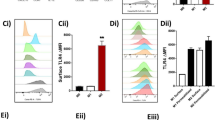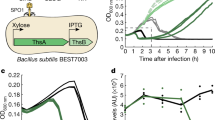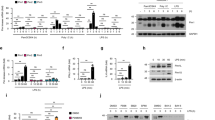Abstract
Lipopolysaccharide activates plasma-membrane signaling and endosomal signaling by Toll-like receptor 4 (TLR4) through the TIRAP-MyD88 and TRAM-TRIF adaptor complexes, respectively, but it is unclear how the signaling switch between these cell compartments is coordinated. In dendritic cells, we found that the p110δ isoform of phosphatidylinositol-3-OH kinase (PI(3)K) induced internalization of TLR4 and dissociation of TIRAP from the plasma membrane, followed by calpain-mediated degradation of TIRAP. Accordingly, inactivation of p110δ prolonged TIRAP-mediated signaling from the plasma membrane, which augmented proinflammatory cytokine production while decreasing TRAM-dependent endosomal signaling that generated anti-inflammatory cytokines (interleukin 10 and interferon-β). In line with that altered signaling output, p110δ-deficient mice showed enhanced endotoxin-induced death. Thus, by controlling the 'topology' of TLR4 signaling complexes, p110δ balances overall homeostasis in the TLR4 pathway.
This is a preview of subscription content, access via your institution
Access options
Subscribe to this journal
Receive 12 print issues and online access
$259.00 per year
only $21.58 per issue
Buy this article
- Purchase on SpringerLink
- Instant access to full article PDF
Prices may be subject to local taxes which are calculated during checkout







Similar content being viewed by others
Change history
08 April 2013
In the version of this article initially published, the eighth author was identified incorrectly. The correct name is Inma M Berenjeno, and the initials should be I.M.B. in the Author Contributions section. The error has been corrected in the HTML and PDF versions of the article.
References
Janeway, C.A. Jr. & Medzhitov, R. Innate immune recognition. Annu. Rev. Immunol. 20, 197–216 (2002).
Akira, S. & Takeda, K. Toll-like receptor signalling. Nat. Rev. Immunol. 4, 499–511 (2004).
Kagan, J.C. & Medzhitov, R. Phosphoinositide-mediated adaptor recruitment controls Toll-like receptor signaling. Cell 125, 943–955 (2006).
Kagan, J.C. et al. TRAM couples endocytosis of Toll-like receptor 4 to the induction of interferon-beta. Nat. Immunol. 9, 361–368 (2008).
Di Paolo, G. & De Camilli, P. Phosphoinositides in cell regulation and membrane dynamics. Nature 443, 651–657 (2006).
McLaughlin, S., Wang, J., Gambhir, A. & Murray, D. PIP2 and proteins: interactions, organization, and information flow. Annu. Rev. Biophys. Biomol. Struct. 31, 151–175 (2002).
Barton, G.M. & Kagan, J.C. A cell biological view of Toll-like receptor function: regulation through compartmentalization. Nat. Rev. Immunol. 9, 535–542 (2009).
Heo, W.D. et al. PI(3,4,5)P3 and PI(4,5)P2 lipids target proteins with polybasic clusters to the plasma membrane. Science 314, 1458–1461 (2006).
Cantley, L.C. The phosphoinositide 3-kinase pathway. Science 296, 1655–1657 (2002).
Vanhaesebroeck, B., Guillermet-Guibert, J., Graupera, M. & Bilanges, B. The emerging mechanisms of isoform-specific PI3K signalling. Nat. Rev. Mol. Cell Biol. 11, 329–341 (2010).
Graupera, M. et al. Angiogenesis selectively requires the p110α isoform of PI3K to control endothelial cell migration. Nature 453, 662–666 (2008).
Guillermet-Guibert, J. et al. The p110β isoform of phosphoinositide 3-kinase signals downstream of G protein-coupled receptors and is functionally redundant with p110γ. Proc. Natl. Acad. Sci. USA 105, 8292–8297 (2008).
Hirsch, E. et al. Central role for G protein-coupled phosphoinositide 3-kinase γ in inflammation. Science 287, 1049–1053 (2000).
Okkenhaug, K. et al. Impaired B and T cell antigen receptor signaling in p110δ PI 3-kinase mutant mice. Science 297, 1031–1034 (2002).
Koyasu, S. The role of PI3K in immune cells. Nat. Immunol. 4, 313–319 (2003).
Fukao, T. et al. PI3K-mediated negative feedback regulation of IL-12 production in DCs. Nat. Immunol. 3, 875–881 (2002).
Guha, M. & Mackman, N. The phosphatidylinositol 3-kinase-Akt pathway limits lipopolysaccharide activation of signaling pathways and expression of inflammatory mediators in human monocytic cells. J. Biol. Chem. 277, 32124–32132 (2002).
Brown, J., Wang, H., Suttles, J., Graves, D.T. & Martin, M. Mammalian target of rapamycin complex 2 (mTORC2) negatively regulates Toll-like receptor 4-mediated inflammatory response via FoxO1. J. Biol. Chem. 286, 44295–44305 (2011).
Low, P.C. et al. Phosphoinositide 3-kinase δ regulates membrane fission of Golgi carriers for selective cytokine secretion. J. Cell Biol. 190, 1053–1065 (2010).
Stephens, L., Ellson, C. & Hawkins, P. Roles of PI3Ks in leukocyte chemotaxis and phagocytosis. Curr. Opin. Cell Biol. 14, 203–213 (2002).
Botelho, R.J. et al. Localized biphasic changes in phosphatidylinositol-4,5-bisphosphate at sites of phagocytosis. J. Cell Biol. 151, 1353–1368 (2000).
Stauffer, T.P., Ahn, S. & Meyer, T. Receptor-induced transient reduction in plasma membrane PtdIns(4,5)P2 concentration monitored in living cells. Curr. Biol. 8, 343–346 (1998).
Grinstein, S. Imaging signal transduction during phagocytosis: phospholipids, surface charge, and electrostatic interactions. Am. J. Physiol. Cell Physiol. 299, C876–C881 (2010).
Papayannopoulos, V. et al. A polybasic motif allows N-WASP to act as a sensor of PIP2 density. Mol. Cell 17, 181–191 (2005).
Lemmon, M.A., Ferguson, K.M., O'Brien, R., Sigler, P.B. & Schlessinger, J. Specific and high-affinity binding of inositol phosphates to an isolated pleckstrin homology domain. Proc. Natl. Acad. Sci. USA 92, 10472–10476 (1995).
Gray, A., Van Der Kaay, J. & Downes, C.P. The pleckstrin homology domains of protein kinase B and GRP1 (general receptor for phosphoinositides-1) are sensitive and selective probes for the cellular detection of phosphatidylinositol 3,4-bisphosphate and/or phosphatidylinositol 3,4,5-trisphosphate in vivo. Biochem. J. 344, 929–936 (1999).
Gillooly, D.J. et al. Localization of phosphatidylinositol 3-phosphate in yeast and mammalian cells. EMBO J. 19, 4577–4588 (2000).
Mansell, A. et al. Suppressor of cytokine signaling 1 negatively regulates Toll-like receptor signaling by mediating Mal degradation. Nat. Immunol. 7, 148–155 (2006).
Cao, X. et al. The inositol 3-phosphatase PTEN negatively regulates Fcγ receptor signaling, but supports Toll-like receptor 4 signaling in murine peritoneal macrophages. J. Immunol. 172, 4851–4857 (2004).
Gunzl, P. et al. Anti-inflammatory properties of the PI3K pathway are mediated by IL-10/DUSP regulation. J. Leukoc. Biol. 88, 1259–1269 (2010).
Leslie, N.R., Dixon, M.J., Schenning, M., Gray, A. & Batty, I.H. Distinct inactivation of PI3K signalling by PTEN and 5-phosphatases. Adv. Enzyme Regul. 52, 205–213 (2011).
Keck, S., Freudenberg, M. & Huber, M. Activation of murine macrophages via TLR2 and TLR4 is negatively regulated by a Lyn/PI3K module and promoted by SHIP1. J. Immunol. 184, 5809–5818 (2010).
Sly, L.M. et al. SHIP prevents lipopolysaccharide from triggering an antiviral response in mice. Blood 113, 2945–2954 (2009).
Sorimachi, H., Ishiura, S. & Suzuki, K. Structure and physiological function of calpains. Biochem. J. 328, 721–732 (1997).
Peltier, J. et al. Calpain activation and secretion promote glomerular injury in experimental glomerulonephritis: evidence from calpastatin-transgenic mice. J. Am. Soc. Nephrol. 17, 3415–3423 (2006).
Sato, S. et al. Toll/IL-1 receptor domain-containing adaptor inducing IFN-β (TRIF) associates with TNF receptor-associated factor 6 and TANK-binding kinase 1, and activates two distinct transcription factors, NF-κB and IFN-regulatory factor-3, in the Toll-like receptor signaling. J. Immunol. 171, 4304–4310 (2003).
Doyle, S. et al. IRF3 mediates a TLR3/TLR4-specific antiviral gene program. Immunity 17, 251–263 (2002).
Chang, E.Y., Guo, B., Doyle, S.E. & Cheng, G. Cutting edge: involvement of the type I IFN production and signaling pathway in lipopolysaccharide-induced IL-10 production. J. Immunol. 178, 6705–6709 (2007).
Beutler, B. & Cerami, A. Cachectin, cachexia, and shock. Annu. Rev. Med. 39, 75–83 (1988).
Guarda, G. et al. Type I interferon inhibits interleukin-1 production and inflammasome activation. Immunity 34, 213–223 (2011).
Ohtani, M. et al. Mammalian target of rapamycin and glycogen synthase kinase 3 differentially regulate lipopolysaccharide-induced interleukin-12 production in dendritic cells. Blood 112, 635–643 (2008).
Androulidaki, A. et al. The kinase Akt1 controls macrophage response to lipopolysaccharide by regulating microRNAs. Immunity 31, 220–231 (2009).
Laplante, M. & Sabatini, D.M. mTOR signaling in growth control and disease. Cell 149, 274–293 (2012).
Cao, W. et al. Toll-like receptor-mediated induction of type I interferon in plasmacytoid dendritic cells requires the rapamycin-sensitive PI(3)K-mTOR-p70S6K pathway. Nat. Immunol. 9, 1157–1164 (2008).
Guiducci, C. et al. PI3K is critical for the nuclear translocation of IRF-7 and type I IFN production by human plasmacytoid predendritic cells in response to TLR activation. J. Exp. Med. 205, 315–322 (2008).
Zanoni, I. et al. CD14 controls the LPS-induced endocytosis of Toll-like receptor 4. Cell 147, 868–880 (2011).
Katakura, K. et al. Toll-like receptor 9-induced type I IFN protects mice from experimental colitis. J. Clin. Invest. 115, 695–702 (2005).
Zhang, X. et al. Type I interferons protect neonates from acute inflammation through interleukin 10-producing B cells. J. Exp. Med. 204, 1107–1118 (2007).
Crow, M.K. Type I interferon in organ-targeted autoimmune and inflammatory diseases. Arthritis Res. Ther. 12 Suppl 1, S5 (2010).
Uno, J.K. et al. Altered macrophage function contributes to colitis in mice defective in the phosphoinositide-3 kinase subunit p110δ. Gastroenterology 139, 1642–1653 (2010).
Liu, Y. et al. A unique feature of Toll/IL-1 receptor domain-containing adaptor protein is partially responsible for lipopolysaccharide insensitivity in zebrafish with a highly conserved function of MyD88. J. Immunol. 185, 3391–3400 (2010).
Terebiznik, M.R. et al. Elimination of host cell PtdIns(4,5)P2 by bacterial SigD promotes membrane fission during invasion by Salmonella. Nat. Cell Biol. 4, 766–773 (2002).
Wang, N. et al. A PEST sequence in ABCA1 regulates degradation by calpain protease and stabilization of ABCA1 by apoA-I. J. Clin. Invest. 111, 99–107 (2003).
Tompa, P. et al. On the sequential determinants of calpain cleavage. J. Biol. Chem. 279, 20775–20785 (2004).
Klippel, A., Escobedo, J.A., Hirano, M. & Williams, L.T. The interaction of small domains between the subunits of phosphatidylinositol 3-kinase determines enzyme activity. Mol. Cell. Biol. 14, 2675–2685 (1994).
Inaba, K. et al. Generation of large numbers of dendritic cells from mouse bone marrow cultures supplemented with granulocyte/macrophage colony-stimulating factor. J. Exp. Med. 176, 1693–1702 (1992).
Bachmaier, K. et al. E3 ubiquitin ligase Cblb regulates the acute inflammatory response underlying lung injury. Nat. Med. 13, 920–926 (2007).
Nagpal, K. et al. A TIR domain variant of MyD88 adapter-like (Mal)/TIRAP results in loss of MyD88 binding and reduced TLR2/TLR4 signaling. J. Biol. Chem. 284, 25742–25748 (2009).
Foukas, L.C. et al. Critical role for the p110α phosphoinositide-3-OH kinase in growth and metabolic regulation. Nature 441, 366–370 (2006).
Hammond, G.R., Schiavo, G. & Irvine, R.F. Immunocytochemical techniques reveal multiple, distinct cellular pools of PtdIns4P and PtdIns(4,5)P2 . Biochem. J. 422, 23–35 (2009).
Acknowledgements
We thank R. Medzhitov (Yale University) for expression vectors encoding GST-TIRAP, GFP-TIRAP and GST–TIRAP-4x ; S. Akira (Osaka University) and L. O'Neill (Trinity College, Dublin) for TLR4-, MyD88-, TRIF- or TIRAP-deficient mice; L. Stephens (Babraham Institute) for SHIP-1-deficient mice; L. Baud (Hôpital Tenon) for mice with transgenic expression of calpastatin; G. Schiavo (London Cancer Research Institute) for the 2C11 mouse monoclonal antibody to PtdIns(4,5)P2; T. Kinashi (Kyoto University) for the 5′ Myc membrane-targeted version of p110δ in the pMX-neo vector; T. Maffucci (Queen Mary, University of London) for GST–PLC-δ-PH and GST–Akt-PH; H. Stenmark (Oslo University Hospital) for GST–Hrs-FYVE; D. Gray (University of Edinburgh) for the XL-60 cell line; and B. Manoury, N. Leslie and members of the Centre for Cell Signalling for comments. Supported by the European Union Marie Curie (IEF-041713 to E.A. and IEF-274749 to S.T.); the European Molecular Biology Organization (ALTF 1083-2007 to E.A.); the Fondation ARC pour la Recherche sur la Cancer (SAE P2009); the Fund for Scientific Research Flanders; the Hercules Foundation and University of Ghent Multidisciplinary Research Partnership (for work in the laboratory of R.B.); the European Union Marie Curie International Graduate Program in Molecular Medicine (M.A.W.); and Cancer Research UK (C23338/A10200), the Ludwig Institute for Cancer Research and Queen Mary University of London (for work in the laboratory of B.V.).
Author information
Authors and Affiliations
Contributions
E.A. and B.V. developed the main hypothesis; E.A., S.T., D.T., S.D., A.H., W.P.P., I.M.B., G.N. and V.F. planned studies, did experiments and/or analyzed data; M.A.W., A.F. and R.B. contributed reagents, intellectual input and editorial assistance; E.A. and B.V. wrote the paper; B.V. supervised the project; and E.A. and B.V. obtained funding.
Corresponding authors
Ethics declarations
Competing interests
B.V. is an advisor to Intellikine, GlaxoSmithKline and Activiomics.
Supplementary information
Supplementary Text and Figures
Supplementary Figures 1–8 and Tables 1–2 (PDF 1209 kb)
Rights and permissions
About this article
Cite this article
Aksoy, E., Taboubi, S., Torres, D. et al. The p110δ isoform of the kinase PI(3)K controls the subcellular compartmentalization of TLR4 signaling and protects from endotoxic shock. Nat Immunol 13, 1045–1054 (2012). https://doi.org/10.1038/ni.2426
Received:
Accepted:
Published:
Issue date:
DOI: https://doi.org/10.1038/ni.2426
This article is cited by
-
Class I PI3K regulatory subunits control differentiation of dendritic cell subsets and regulate Flt3L mediated signal transduction
Scientific Reports (2022)
-
Late p65 nuclear translocation in glioblastoma cells indicates non-canonical TLR4 signaling and activation of DNA repair genes
Scientific Reports (2021)
-
Orchestrated modulation of rheumatoid arthritis via crosstalking intracellular signaling pathways
Inflammopharmacology (2021)
-
TLR4 and CD14 trafficking and its influence on LPS-induced pro-inflammatory signaling
Cellular and Molecular Life Sciences (2021)
-
Converging TLR9 and PI3Kgamma signaling induces sterile inflammation and organ damage
Scientific Reports (2019)



